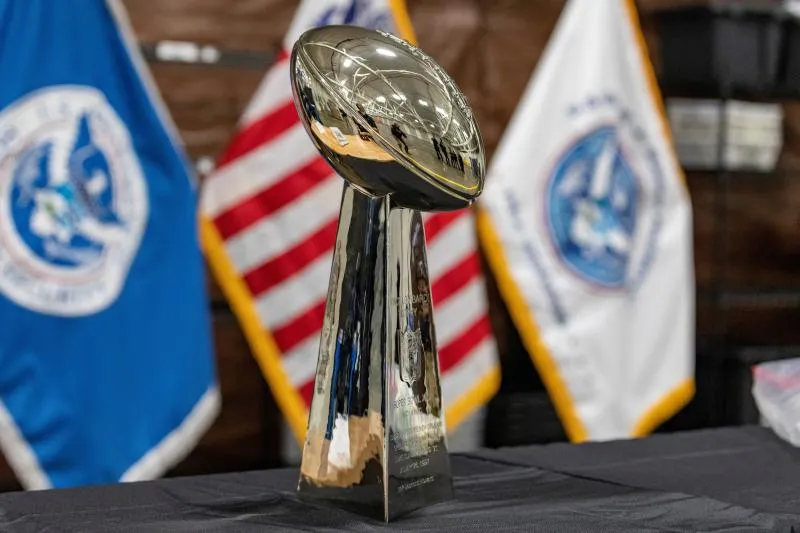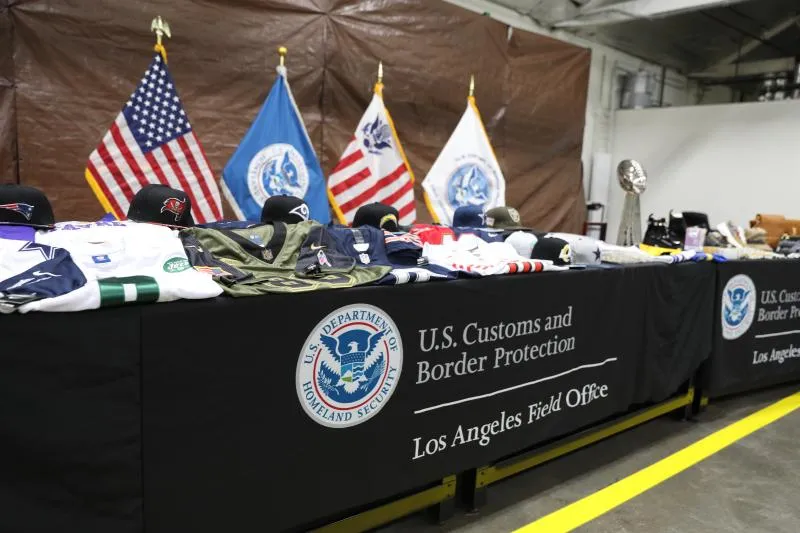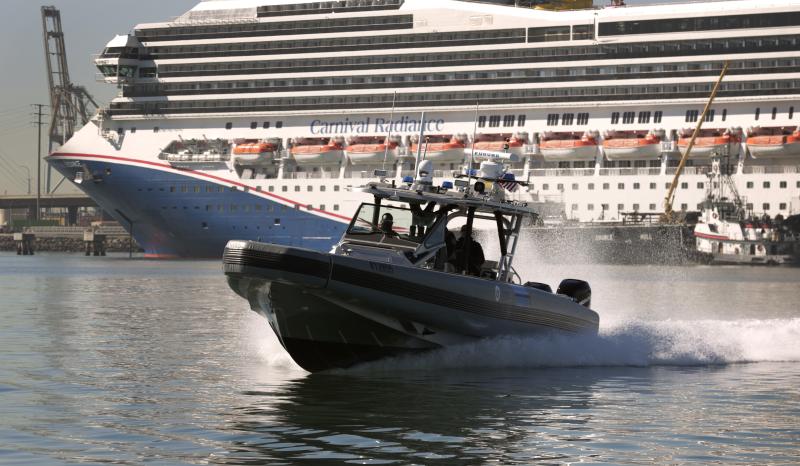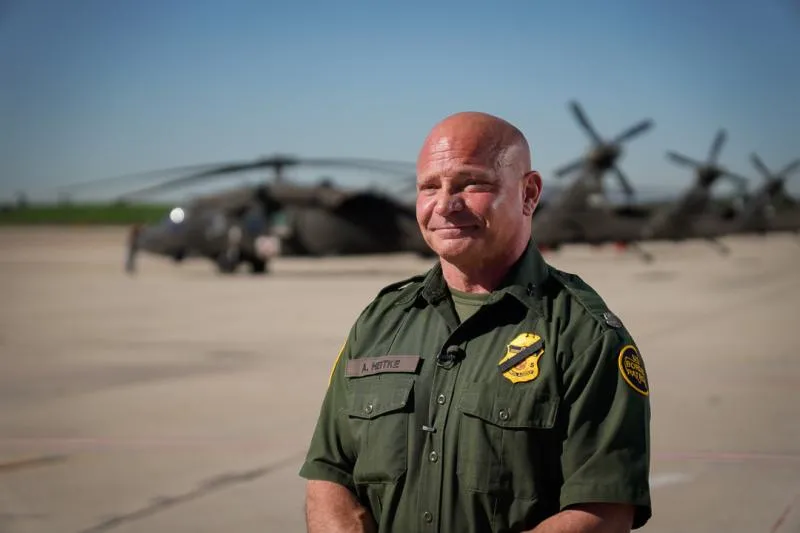CBP’s effort to secure the Super Bowl produces win
by John Davis

one of the last things CBP scanned before the big game. Photo by Mani Albrecht
It was an exciting matchup watched ‘round the world, as the Los Angeles Rams and Cincinnati Bengals and battled to an exciting 23-20 finish, in favor of the Rams. While the Super Bowl kept the thousands of fans in the stadium … and nearly 100 million viewers globally … on the edge of their seats with game-changing dramas seemingly on every set of downs, the security around the game was far less dramatic. And that was just fine with the person in charge of U.S. Customs and Border Protection’s efforts at the game.
“Thank you to all of our partners for all of the cooperation and communication throughout the entire process to make sure it went smoothly, and we didn’t have any major incidents [before or during the game],” said Chief Patrol Agent Aaron Heitke, usually in charge of the U.S. Border Patrol’s busy San Diego Sector and sent just up the road to coordinate CBP’s efforts with the myriad of federal, state and local law enforcement agencies involved in the big game. “Everybody worked together, stayed on the same page, and had seamless interactions through the entire Super Bowl.”
While it wasn’t dramatic for CBP, that doesn’t mean maintaining the security posture was easy. A group of 224 Border Patrol and Air and Marine Operations agents, CBP officers, and civilian employees spent about a week and a half actively on the ground in the Los Angeles area. They scanned trucks entering the stadium area with powerful X-ray machines, flew patrols in the “no-fly zone” surrounding the stadium, and patrolled the waters just off the coast of California, as well as having quick reaction forces standing by in case of emergencies and specialists trained to recognize counterfeit merchandise and the signs of human trafficking.
“Everything went well, and it was a great opportunity for us to shine, to let people know that we’re more than just a presence at the ports of entry,” said Director of Field Operations Carlos Martel, in charge of CBP’s X-ray trucks, intellectual property rights specialists, and CBP officers trained to look for the same telltale signs of illicit activities they look for at the nation’s nearly 330 air, land and sea ports of entry.

Field Operations’ duties during this big game were similar to what CBP officers, intellectual property rights specialists and agriculture specialists – among many other specialized fields – do every day. They scanned 1,673 trucks, vans and other vehicles carrying food, drink and goods into the stadium area, processed visitors who flew in from international locations to see the game, and seized approximately more than $2.4 million worth of trademark infringing merchandise during 176 seizures to make sure no fake items got into unsuspecting consumers’ hands. Martel said the key to success in such a busy environment was the teamwork between the different CBP components, as well as the agency’s law enforcement partners.
“Our staff had some challenges with the volume of vehicles going into the facility, and we scanned 200 to 300 vehicles per day,” Martel said. “We had successful intellectual property rights violation seizures. We denied a lot of individuals entry into the U.S because we were able to connect the dots and stopped human trafficking. It highlighted how involved we are with innovation and technology.”

Angeles area. Photo by Glenn Fawcett
Air and Marine Operations – CBP’s aviation and maritime experts that secure the border by using helicopters and airplanes and on the seas using boats that pound their way across the wavetops to chase down smugglers of drugs and people – had a proportionately larger share of the action. The agents flew 37 flights before and during the game, spending more than 100 hours in the air in total and put to sea for seven missions covering 54 hours – done mostly out of sight from the people they protected, just like they do every day.
“The average American probably didn’t even know we were out there. We flew well before kickoff and after the crowds went home after the Super Bowl,” said Brandon Tucker, director of the San Diego Air and Marine Branch and director of Air and Marine Operations’ efforts at the game. “Last year, we performed more than 400 rescues along the borders, saved people day in and day out, did the counter-narcotics mission, surveillance along the borders and on the seas. We do all of that 24/7. We’re ready for what the American public doesn’t even know could come.”
Air and Marine Operations agents flew around the stadium area and helped maintain that no-fly zone through the conclusion of the game. In addition, one of their coastal interceptor vessel crews maintained a presence out in the Pacific Ocean – not that unusual a task, considering those patrols are part of what keeps the nation’s borders secure throughout the year and not just during the Super Bowl.

California, just ahead of this year’s Super Bowl. Photo by Glenn Fawcett
“It really is up to us to patrol the air and seas that don’t have borders,” said Marine Interdiction Agent Evan Wagley, one of the boat operators who normally patrols the coast from his San Diego base of operations. “There’s no border fence on the water or in the air.”
Part of the success of CBP’s security operations at the big game was the teamwork generated through the seamless integration of the assets and coordinated through the emergency operations center.
“With a venue of this size and the various law enforcement components we had in multiple locations, we were the central hub for both CBP and fed into the other federal coordinators,” said Assistant Chief Patrol Agent Ryan Yamasaki, in charge of the center. “We provided a uniform platform to work across the various components and agencies.”
So while CBP’s security experts didn’t experience the same heart-stopping thrills the game produced, many of the men and women who helped make sure it was a quiet security event got their own thrills just from being part of the experience.
“This was my first Super Bowl I’ve worked,” said Aviation Enforcement Agent Beata Levy, who watched the video and radars and redistributed the live feeds to agencies on the ground from the aircraft thousands of feet above and felt a bit like a rookie coming off the bench for their first big game. “I was glad everything went smoothly and everyone was safe.”
Heitke reiterated his pleasure at seeing an exciting game – but a boring security event.

“That was the dream outcome,” he said with a smile, heading back to his regular work of securing the southern border and sending the other more than 200 agents, officers and civilian employees back to their posts along lonely stretches of remote desert areas, in X-ray trucks that check each and every container that comes into the country, and at air and land ports to make sure people aren’t exploited in the crime of human trafficking. “We’re glad to get everyone home safe afterward.”

